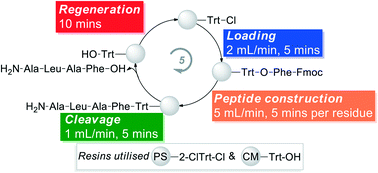A continuous flow protocol to generate, regenerate, load, and recycle chlorotrityl functionalised resins†
Abstract
From a screen of chlorinating agent concentration, flow rates, and reagent addition methodologies, a continuous flow protocol to activate, reactivate, and recycle both 2-chlorotrityl chloride functionalised polystyrene and trityl-hydroxy ChemMatrix functionalised resins was established. This protocol significantly reduced resin loading periods. Under batch conditions, previously reported trityl resin chlorination protocols are effected over 1–24 hours whereas the continuous flow chlorination procedure was completed within 10 min. Further amino acid residue tethering to the resin was effected within 5 min as opposed to the 2-hour loading period typically applied under batch conditions. Moreover, an injection-based continuous-flow methodology proved effective in maintaining the chiral integrity of Fmoc-His(Trt)-OH, Fmoc-Cys(Trt)-OH, and Fmoc-Ser(t-Bu)-OH, which are susceptible to direct base-induced epimerisation. Further, through incorporating the optimised AcCl resin chlorination protocol into a continuous flow solid-phase peptide construction procedure, a facile and resin recyclable approach to conduct SPPS was established.



 Please wait while we load your content...
Please wait while we load your content...